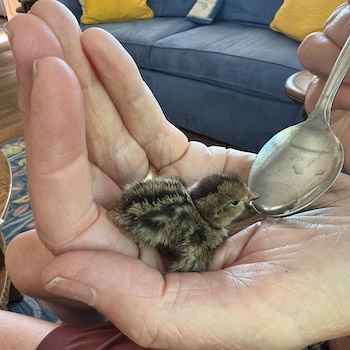
I read an article long ago, which I have not been successful in locating again since, that (as I remember it at least) described a few reasons why when we run into people we know, it’s not as statistically improbable as we think. I was excited recently to run across the book The Improbability Principle by David Hand, whose subtitle is “Why coincidences, miracles and rare events happen every day.”
Now, I have learned enough math over the years to graduate summa cum laude with an engineering degree and enjoy a successful engineering career, but I am by no means a math whiz. The examples in The Improbability Principle make it an enjoyable and interesting read, but I’m not gonna lie, it quickly gets very dense in technical concepts. The author Hand walks us through three different kinds of probability: frequentist, subjective and classical definitions. But while there may be (at least) three different ways of thinking about probability, it’s the same math for all three.
This year our neighbors across the alley had their first son, who was born on the Fourth of July. I had never thought of this, but someone recently pointed out that the only date that we Americans regularly state in the European convention of DMY instead of our usual American convention of MDY is the date on which we declared our independence from Europe. Since both our neighbors were born in Europe, but have at least for the time being adopted the US as their country, it was kind of cool that their first son was born on the Fourth. They were able to watch fireworks from the hospital bed!
The probability of being born on a particular date is small, but I remember a junior high math class in statistics where the teacher said that the chances were actually pretty good, in a class of 30-odd students like ours, that two people had the same birthday. I remember thinking, 30 students, 365 days, not great odds. But as we went around the room, there were indeed two students that had the same birthday! This is actually known as the Birthday Paradox; in a room of 23 people, the chances of two of them having the same birthday is slightly over 50%. For our class of 30, the probability was almost 70%! The math doesn’t lie.
So I was not unduly surprised when I realized that a friend in Missoula who we had just visited on our latest road trip, ALSO had their son born on the Fourth of July. But it did give me pause that both of the dads names are Brendan, in fact they are the only two Brendans I know! Missoula Brendan is Brendan Leonard, a talented author, artist and humorous illustrator, creator of Semi-Rad. Among other great projects, he came up with Practice Maximum Enthusiasm, which I love, and own the t-shirt, and has the distinction of being on my [very short] list of possible-tattoos-which-I-will-probably-never-get-but-if-I-did-it-would-be-one-of-these. In an act of selfless service that almost put him into my last will and testament, Brendan drove a fresh pie from Missoula to Big Fork when my neighbor Mike and I were camped there while biking on the Great Divide in 2021.
With apologies to any real mathematicians, I determined to calculate the approximate probability that two of my friends, named Brendan, would each have their first sons born on the Fourth of July. I started with the chances that I would know two people named Brendan. My contacts list around 4,000, so assuming half are male, that’s about 2000 males I know in some capacity. I guessed that my friends are aged 35-40, so checked the years 1988 to 1992 for prevalence of Brendan as a first name. First surprise was that for many of those years, there were 12-13 girls born with the name of Brendan, who knew? In that 5-year period, there were 10,422 baby boys named Brendan, out of 10,401,658 male babies. This is for the U.S., and an approximation, since I happen to know our neighbor Brendan was born in Ireland, and I’m guessing the percentage of ‘Brendan’ babies in Ireland may be just slightly higher than for the U.S. With that approximation, the chance of a male of that age being named Brendan is about 1 in 1000. So the chance of there being exactly two Brendans in the roughly 2000 males I know, calculated by the binomial probability formula, would be about .5, actually pretty decent odds as it turns out.
Next is the issue of birth dates – it turns out that statistically, some dates have slightly larger or smaller probabilities than the 1/365 that you would expect, leading one to suspect there may be other, non-random factors involved. Turns out, looking at life insurance applications from 1981 – 1994 at least, in 480,040 birthdays listed, July 4 came up 1265 times in lieu of the anticipated 1314 times.
By my rough, and as already established, unqualified calculations, for the independent occurrences of my knowing two Brendans, and each of them having a son born on July 4, works out to 0.5*.002635*.002635, or about 1 in 300,000. So that seems rare, but probably not as improbable as I would have guessed off the top of my head.
The great thing about math is you can see how if you tweak the input numbers it changes the results. I was recently chatting with a LONGTIME friend (we have been friends longer than Francie and I have been married, and that’s over 41 years) about road trips. I was explaining how we like to use road trips to visit friends. She was saying that she didn’t have that many friends around the country. You can see from the calculations above, the more people I know, the greater the chances that I will know a Brendan or two… or someone who lives in Missoula for instance. Not sure it makes sense to take advice on increasing the number of friends from an introvert, but I find the more I talk to people, the more friends I get. Also, the more I think about what I can do for others, the more friends I get. And the more I take time to write notes, the more friends I get. Sure, it’s a little work, and not always comfortable, but it sure is fun pulling up a map and seeing all those pins of people I know!
I hope you have all the friends you want, or are working on increasing your probabilities!





